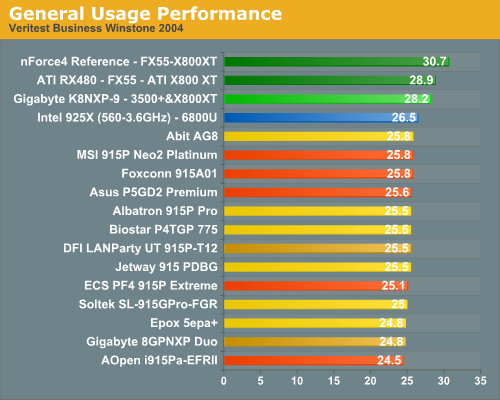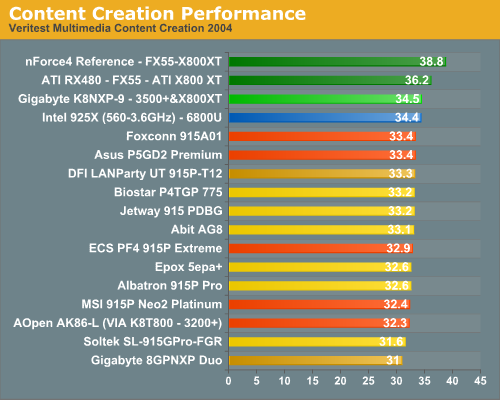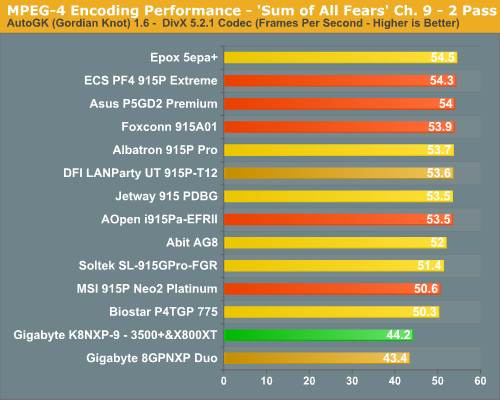915 Motherboard Roundup: Socket 775 for the Rest of Us
by Wesley Fink on December 7, 2004 12:25 AM EST- Posted in
- Motherboards
General Performance and Encoding




All tested motherboards were based on the same Intel 915 chipset and tested with the same CPU. The only difference was the memory supported by the board - either DDR or DDR2. So was DDR or DDR2 the winner? As we saw in our launch review for the 925X/915, the performance of fast DDR400 and DDR2-533 at aggressive timings is about the same. Having said that, some will still be surprised to see that there is really no winner in DDR or DDR2 in Winstones, even though we are comparing fast 2-2-2-5 DDR400 to fast DDR2-533 at 3-3-3-10. There is also no clear pattern of DDR2 or DDR performing better in these results. It appears that the performance is more dependent on the quality of the design than the type of memory used by the 915 board.
The same is true in results for PCMark 2004. There is a greater overall variation in PCmark scores, but no real pattern in terms of the type of memory used on the board. However, it is surprising to see such a wide range of results on PCMark 2004 tests on boards using the same chipset. The range of scores from 5000 to almost 5700 using the same CPU is extremely large. You will definitely see the performance difference in these boards. All the boards, but 4, are clustered between 5457 to 5690, but the bottom 4 boards are significantly slower with scores from 5007 to 5310.
2-pass Media Encoding results with AutoGk 1.6 and the DivX 5.2.1 Codec also reveal no clear performance pattern with either DDR or DDR2. You can choose either memory on a 915 board and be confident that performance will be competitive with other 915 boards and memory configurations.
One pattern that will emerge as we take a closer look at the benchmarks is that the same few motherboards are at the top of our test results over and over again. This will be even clearer in the DirectX 9 gaming tests. For those of you interested in comparisons to the Athlon 64, it is interesting that the FX55 totally dominates Winstones. On the other side, PCMark 2004 is dominated by the Intel boards. Clearly, both results cannot be correct, but are more a reflection of the design of each test and the features supported in each benchmark.










26 Comments
View All Comments
krelian - Wednesday, December 8, 2004 - link
I been a Intel user since the first Pentium 3 came out now I have a Intel P4 3.0C I refused to spend more money on things I had already bought so I stayed with the 478 socket, seeing as Intel wants me to move to an expensive platform, I say I'll ditch Intel head with the AMD crowd, I'm sure I won't be the only one, maybe legions of intel campers will leave.ChineseDemocracyGNR - Tuesday, December 7, 2004 - link
About the config I put together in the previous post; does anyone know if the overclock lock on the 915P chipsets apply to lower FSB's too? Could I overclock the 133MHz Celeron D to 200MHz on any 915P motherboard?ChineseDemocracyGNR - Tuesday, December 7, 2004 - link
The 915P chipset provides good value for the money. For example:ECS 915P-A $79
Intel Celeron D 325J 2.53GHz $88
Albatron GeForce 6600 128MB $120.50
or
Albatron GeForce 6600GT 128MB $190.50
(newegg prices)
The processor can be overclocked to 3.6+GHz very easily, much like the Athlon Mobiles.
That makes a good budget gaming rig, better than anything you could put together with an AMD processor for the same money. So, at least in my opinion, AMD has a better mainstream/high-end processor, and Intel wins the value segment. Who would say?
--
I have now read the entire article, and oh boy! Though I prefer to read about socket 754/939 motherboards, this has to be the best motherboard roundup I ever read. Ever. Well done.
--
#22,
thank your fixing it. The typo I wrote about on page 10:
"The fact that Asus manages a higher OC than more recognized OC boards like DFI and Asus "
Don't you mean ABIT in the last word there?
ocyl - Tuesday, December 7, 2004 - link
Wesley > Thank you for paying attention to the audio features/components of these motherboards, particularly Dolby Digital Live :)Wesley Fink - Tuesday, December 7, 2004 - link
#21 - The Foxconn results have been corrected on p.20. Thank you for bringing it to our attention.ChineseDemocracyGNR - Tuesday, December 7, 2004 - link
A few typos:"The fact that Asus manages a higher OC than more recognized OC boards like DFI and Asus "
page 10.
On page 20, the "Front Side Bus Overclocking Testbed" table is probably wrong.
---
Good article.
LeadFrog - Tuesday, December 7, 2004 - link
Why does only the socket 915 get a 16mb cache Hard Drive?danidentity - Tuesday, December 7, 2004 - link
Wes, I said thanks before but I'll say it again, great roundup. We appreciate your hard work, always.danidentity - Tuesday, December 7, 2004 - link
Live -The P5GD2 is expensive compared to most boards, but it includes a ton of stuff, like 8 SATA ports, dual gigabit LAN, on-board 802.11g/b, and on-board hi-def audio with Dolby Digital Live (realtime encoding, like SoundStorm).
Most 915P boards aren't as close to as expensive as the Asus. The Abit AG8 is ~ $130, equal or cheaper in price than the K8N Neo2.
Wesley Fink - Tuesday, December 7, 2004 - link
#16 - After I did the price analysis today I changed "outstanding value" to "good value". Thanks for the comment about the review being good reading. It is appreciated as a huge amount of work went into this roundup.